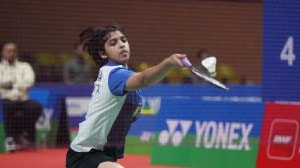India’s MVP Most Valuable Player Most Vital Problem
Sandeep Dwivedi and K Shriniwas Rao try to figure out Indian cricket’s biggest dilemma - Irfan Pathan, the 21-year-old caught in a Catch 22 situation. Pace or swing, batting or bowling, top-order or tailender, these are the tough choices that makes ICC’s Most Promising Cricketer of 2004, the Most Confused Cricketer in 2006.

Fists clenched, teeth tightly locked and his curly mop of hair flying in the wind after a vigorous shake of the head. That was Irfan Pathan during his 2003-04 debut season as he yorked Adam Gilchrist in Australia.
Cut to the 2006 West Indies tour and one realises how things have changed. The clenched fist has been swapped for crossed fingers, the teeth nervously biting fingernails, and as for the hair; those tousled locks are a thing of the past. From being ICC’s most promising international player in 2004, the 21-year-old can now qualify as the most confused international player.
Balwinder Singh Sandhu, Baroda’s coach who is constantly in touch with the troubled bowler, won’t utter a single word about Pathan. ‘‘Please keep me out of it. If I speak out, it might not go down well with a lot of people,’’ he says.
‘‘I will just say one thing, Irfan should take a 15-day break and go away where nothing can bother him. No Chappell, no Dravid, no cricket and most importantly, no media. Just give him the liberty not to think about cricket at all for some time.’’
In a nutshell: Leave him alone. That is something that has never happened, from the time Pathan got his first Test cap in December, 2003 and scalped Mathew Hayden with his 13th ball in international cricket.
They called him the Next Wasim Akram, the Next Kapil Dev, the Next Real All-rounder and even the Gen Next pace spearhead. But now the flattering praise has given way to snide remarks. First they said he had lost his swing, then his pace, and after the forgettable ODI series in West Indies, he lost a place in the Test XI and going by Chappell’s words his confidence too. Now, his 67 wickets in 25 Tests too are being freshly scrutinised and fingers are being pointed to his 39 scalps against minnows — Bangladesh and Zimbabwe.
The MVP status
But if one goes beyond the exaggeration one understands the importance of being Irfan Pathan. Keeping his significance in the Greg Chappell-Rahul Dravid Vision 2007 in mind, ‘Mending Pathan’ then, becomes a national concern. Wasim Akram explains the young pacer’s MVP status. ‘‘He is definitely a match-winner in his own right. The team certainly needs to understand that he is India’s best strike bowler at the moment and very important for their future plans,’’ he says.
Chappell understands this well. Pathan’s elevation in the batting order is his only successful experiment, and his five-bowler strategy rests largely on the pacer’s batting ability.
During India’s recent historic ODI ‘chasing streak’, India went with five-bowlers in 21 of the 27 games played since the Sri Lankan series last October. Besides, out of the 11 ODI’s that has seen Pathan move up the order, India has won seven. MS Dhoni is the other frequently elevated batsman, but that has been less productive. Though Dhoni has a 183 at No. 3 and 96 as an opener, India has only won two of the six ODI’s that saw the wicket-keeper move up.
Breathless after elevation
While Pathan’s batting is vital for Team India, experts feel that it is this extra burden of padding up minutes after a longish bowling spell that gives the potential all-rounder a jaded look. ‘‘He is certainly the golden goose and the team management needs to use him judiciously. Just because he’s a left-hander and bats well, doesn’t make him a Neil Harvey. If his bowling is being affected then some control has to be brought over the way he is used.’’ says Ajit Wadekar.
According to a study in the British Journal of Sports Medicine, fast bowlers increase their risk of injury when they bowl more than 20-30 overs a week (see box). There are two important aspects that put things in perspective and to a degree explain his dip in form.
One: The batting adds to his extra burden and subsequently he overshoots the standard exertion barrier. So why hasn’t he broken down? That’s where the second point creeps in: He isn’t a fast bowler anymore as his average speed of 125 to 130 kmph makes him a military medium pacer.
Former Indian pacer Venkatesh Prasad says how it’s almost impossible to run through a side by bowling in 120s.‘‘The movement of the ball becomes insignificant if it’s not coupled with speed,’’ he says.
So was promoting Pathan up the order the main reason for his dip? Wadekar once again lays emphasis on two words ‘‘judicious use’’. And moving up the order 11 times in 27 games isn’t exactly judicious.
Action correction
But before one even thinks of pasting a ‘handle with care’ label on Pathan, there is an urgent need for some damage control. Former Baroda coach Vinit Wadkar, who spotted Pathan at the nets in 2001 and drafted him for the Ranji quarter-finals, talks about his drastically changed bowling action.
Before one can dismiss this as a minor change, Wadkar explains the repercussions. ‘‘That’s why his pace has decreased. Pace comes 60 per cent from the run-up but it also depends on how fast you bring your arm down and release the ball. Irfan is taking more time now in releasing the ball and he’s also stopping.”
But there are many who don’t agree with the excess workload theory. Former Team India physio Andrew Leipus, dwells on the mental aspect. ‘‘It’s very important for him (Pathan) to remain on a psychological high. But yes, there is talk of added pressure of a heavy workload on Pathan to deliver with both the bat and the ball. He needs to understand what is best for him. If he feels that his bowling is being affected then he needs to make that known,’’ he says.
Pathan has vehemently insisted that he isn’t an all-rounder but Wadekar feels that ‘‘sub-consciously he has started to believe that he does have a responsibility as a batsman too.’’ The former India coach feels that he shouldn’t lose focus from his primary objective. “If his bowling graph has shown a downfall in recent times, then it is precisely because batting is on his mind.’’
‘He shall overcome’
Whatever the problem, most experts agree that Pathan has it in him to make the U-turn. Former Baroda pace bowler Mukesh Narula, says the situation isn’t alarming. ‘‘He’s far more mature than a normal 21-year-old, but to overcome this rough patch he has to grow up a little. He definitely has it in him to make a comeback.”
Another former Baroda player Rakesh Parikh refuses to even acknowledge the fact that Pathan’s performance has dipped, and a day before the final Test at Sabina Park is in denial. ‘‘By the time this article appears he would have taken a five-wicket haul,” he says.
But that was not to be as Pathan didn’t make it to the playing XI yet again at Sabina Park in the final Test against the West Indies. Though this outpouring of sympathy from his home town can be seen as a sign of desperate optimism, it’s exactly what the Indian thinktank and the fans want to believe. They too hope that next year when the Indians land in the West Indies, they will see the Pathan of old.






- 01
- 02
- 03
- 04
- 05

























